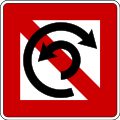Turning point (inland waterway transport)
In German inland shipping, a turning point refers to a section of a river or canal where ships are allowed to change direction. In some cases, this is limited to a maximum ship length by an additional length marking.
purpose
If a ship's cargo has been unloaded or loaded, changing the direction of travel is often expedient. However, due to the available space, this is not possible at every landing point or at every port. It must be borne in mind here that the ships are also getting bigger, especially longer. In order to continue turning, more and more turning points are designated or newly built.
Labelling
Turning points are marked with the illustration E.8 "Note on a turning point" or "Note on a turning point for vehicles up to the length specified on the additional board". The counterpart to this is the U-turn prohibition, which is marked with the illustration A.8 “U-turn prohibition”.
Dimensioning
When dimensioning turning points, the guidelines for standard cross-sections of inland waterway canals should be observed. Here are some excerpts:
- They are to be planned at appropriate intervals (the proximity to a business location is crucial).
- They should be planned as a trapezoidal, one-sided bulge (this avoids possible wedging across the direction of flow).
- It should enable free, unmoored turning.
Individual evidence
- ↑ Establishment of a new turning point above the Niederfinow ship lift , accessed on January 27, 2016.
- ↑ Bottleneck in the Weser fairway , accessed on January 27, 2016.
- ↑ a b ELWIS (Electronic Waterways Information System) ( Memento of the original from March 4, 2016 in the Internet Archive ) Info: The archive link was inserted automatically and has not yet been checked. Please check the original and archive link according to the instructions and then remove this notice. , List of signs of the inland waterway traffic regulations, accessed on January 27, 2016.
- ↑ Guidelines for standard cross-sections of inland waterway canals , in particular Paragraphs 59-61 (accessed on January 27, 2016)

